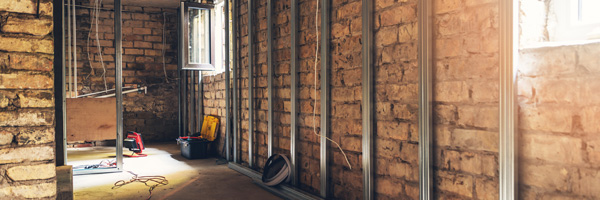
If you’re not sure what kinds of structural repairs are covered by your home insurance policy, you aren’t alone. Home damage happens in many different forms and it’s not always obvious when your home has structural damage. The integrity of your home’s structure can slightly deteriorate over time or get ruined rapidly in a severe storm.
Find out what structural damage is covered under most homeowners insurance policies. Plus, learn about additional insurance policies that can help you get the best protection for your home.
What is structural damage to a building?
You will notice structural damage immediately in many cases. Inside your home, things like ceiling damage, a cracked chimney or slanted floors are easy to spot. Licensed home inspectors primarily look at the four pillars which are the foundation, floor, walls and roof. Cracking, sagging, shifting or missing features on any of the pillars may be considered structural damage if the ruin is severe.
Does home insurance cover structural problems?
The part of your home insurance policy that covers the home structure specifically is often referred to as dwelling protection. This sets it apart from other coverages within your homeowners policy such as personal property protection or liability protection.
The source of your home damage plays a primary role in whether your home insurance policy will cover the costs for structural repairs. Two of the factors insurance companies usually consider are:
- What caused the structural damage?
- What kind of destruction occurred?
The Insurance Information Institute (III) says, “your homeowners policy pays to repair or rebuild your home if it is damaged or destroyed by fire, hurricane, hail, lightning or other disasters listed in your policy.” However, the following circumstances are not covered by home insurance:
- Damage caused by a flood
- Destruction from an earthquake
- Routine wear and tear
In short, not all ruin from natural disasters is covered by a home insurance policy. Regular wear and tear are not considered covered losses. Luckily, there are different ways to supplement your home insurance to get extra protection for your needs.

Learn about our
Home Insurance
Additional coverage to consider for your home
-
Flood Insurance
This can cover costs to repair or replace your home if it is damaged by a flood. The Federal Emergency Management Agency (FEMA) categorizes a flood as “an excess of water on land that is normally dry, affecting two or more acres of land or two or more properties.” Flood insurance offers coverage for the building and contents. Learn more about flood insurance here.
-
Earthquake Insurance
This covers dwelling and personal property loss in the event your home is damaged by an earthquake. There is also additional living expense (ALE) coverage for temporary housing, meals and other services while your home is repaired. Learn more about earthquake insurance here.
-
Fallen Tree Damage Coverage
There are many factors that contribute to determining the coverage if a tree falls on your property and damages your home. For example, a healthy tree falling during a severe storm has different coverage potential than a neglected tree falling on your home. Talk to your insurance agent to see what types of loss are covered on your policy and figure out if you should consider additional coverage.
5 structural repairs most home insurance will cover
Homeowners insurance does cover some structural damage. Here are five home structural repairs or rebuilds you can expect your home insurance policy to cover:
- Roof damage from a severe storm.
- A total collapsed roof from the weight of snow or ice.
- Damage from an accidental vehicle crash into your home.
- Destruction from an accidental explosion.
- Ruin from an accidental fire.
Every insurance company offers different protection, so it’s important for you to know exactly what your policy says. If you have questions about home insurance policies, talk to a Grange independent agent to learn more.
How to fix structural damage
Find the right licensed contractor to complete structural repairs on your home. Roofing contractors can repair your roof and replace damaged or missing shingles. Construction contractors can repair cracked walls, fix slanted floors and mend issues in your home foundation.
Choose home coverage that meets your needs
You need a home insurance policy that offers great coverage with discounts and multiple ways to pay. Choose Grange Insurance to protect your home and property. You can expect great customizable dwelling, personal property, personal liability, equipment breakdown, identity theft coverage and more. Talk to a Grange independent agent today for more details.
This article is for informational and suggestion purposes only. Implementing these suggestions does not guarantee coverage. If any policy coverage descriptions in this article conflict with the language in the policy, the language in the policy applies. For full details on Grange’s home insurance coverages and discounts, contact your local independent agent.
References
Home Inspection Insider
Insurance Information Institute (III)
Floodsmart.gov
Insurance.ca.gov